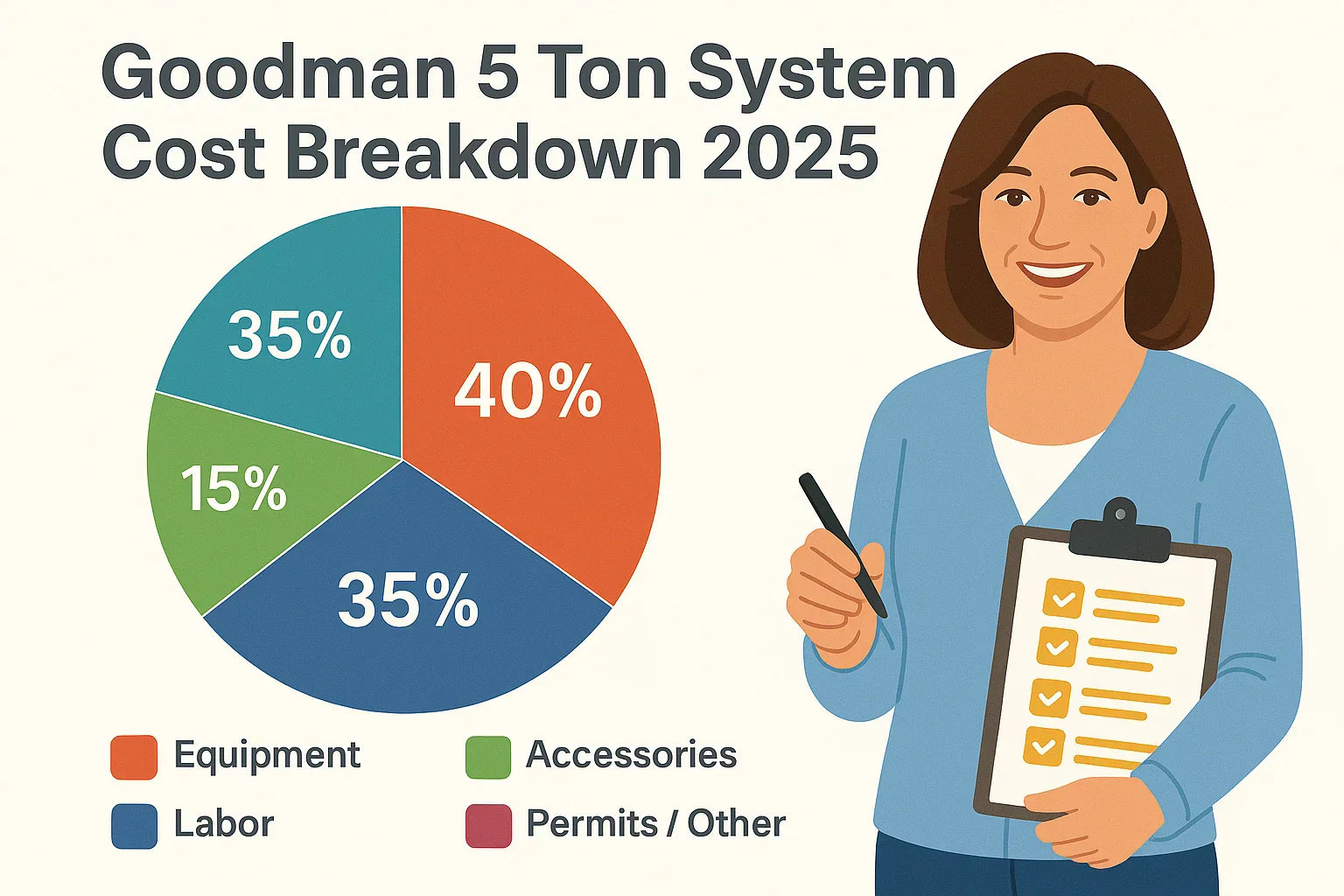When you’re planning to replace your HVAC system, the first question that usually comes up is: “How much is this going to cost me?”
If you’re looking at a Goodman 5 Ton 14 SEER2 R-32 Air Conditioner paired with an 80,000 BTU natural gas furnace, you’re shopping for one of the most common setups for medium-to-large homes. But here’s the truth: the sticker price you see online isn’t the full story.
In 2025, the total cost of a Goodman 5-ton combo system depends on more than just the equipment. There are installation variables, accessories, permits, and even long-term energy savings to think about. In this guide, I’ll walk you through the real numbers homeowners should expect—based on my experience, contractor quotes, and industry averages.
🏷️ Equipment Cost: Goodman 5 Ton Combo System
Let’s start with the basics: the equipment itself.
A Goodman 5 Ton 14 SEER2 R-32 system includes three key parts:
-
Air Conditioner Condenser (GLXS4BA6010)
-
R-32 refrigerant (future-proof, eco-friendly).
-
Provides 60,000 BTUs of cooling.
-
-
Vertical Coil (CAPTA6030C3)
-
Connects the condenser to the furnace.
-
Transfers heat between refrigerant and air.
-
-
Gas Furnace (GR9S800805CN, 80 AFUE, 80k BTUs)
-
Delivers winter heating.
-
Efficiency rating: 80% AFUE (standard in many regions).
-
💵 Typical 2025 equipment cost:
-
Condenser: $2,800–$3,500
-
Furnace: $1,800–$2,500
-
Coil: $800–$1,200
-
Total equipment only: $4,500–$6,500
Goodman is positioned as a value brand—durable, reliable, and affordable compared to premium names like Lennox or Carrier.
🛠️ Installation Cost: The Big Variable
Here’s where things really swing: installation.
Even if you buy the equipment for $5,000, you still need a licensed contractor to install it, connect the refrigerant, run gas lines, and commission the system.
2025 labor averages for a 5-ton Goodman system:
-
Basic installation: $3,500
-
Standard installation with electrical/gas updates: $4,500–$5,500
-
Complex installs (tight spaces, ductwork changes): $6,000+
Why the wide range?
-
Labor rates vary by region. (California is ~30% higher than Midwest states).
-
Urban installs cost more than rural ones.
-
If your home needs upgrades (like new ducts, breakers, or venting), costs rise quickly.
👉 Samantha’s tip: Get at least 3 quotes and ask each contractor to detail what’s included.
For a nationwide perspective, see HVAC Cost Guide ✔️.
📋 Permits, Inspections & Hidden Fees
Most homeowners forget about this part—but cities don’t.
-
HVAC Permit: $150–$500 depending on your location.
-
Electrical Permit: Sometimes separate ($75–$250).
-
Gas Line Permit: If modifications are needed ($100–$200).
-
Inspection Fees: Often bundled, but some cities charge $100–$150 per visit.
💵 Total average permits & fees: $300–$800
Lesson learned: In my project, permits added about $450 to the final bill—but skipping them isn’t worth the risk. Inspections protect you and keep your warranty valid.
🧩 Accessories That Add Up
Your base system may run fine without extras, but many homeowners (me included) choose add-ons for comfort, safety, or efficiency.
-
Smart Thermostat: $150–$400
-
Air Cleaner / UV Purifier: $300–$800
-
Condensate Pump: $100–$300 (needed if the drain can’t flow by gravity).
-
Ductwork modifications: $500–$2,000 if your existing ducts aren’t sized for 5 tons.
-
Surge Protector: $150–$300 (protects the compressor).
💵 Accessories subtotal: $300–$3,000 (depending on choices)
👉 Samantha’s tip: Budget for at least one extra (smart thermostat is my must-have).
📊 Total Installed Cost Range
So what’s the grand total? Here’s what homeowners can expect in 2025:
-
Budget Install (simple swap-out): ~$8,000
-
Average Install (equipment + standard labor + permits): $10,000–$11,000
-
High-End Install (ductwork + extras + city permits): $12,000–$14,000
This lines up with cost data from Forbes Home HVAC Guide ✔️.
🌍 Energy Savings & SEER2 Payback
Here’s where the Goodman 14 SEER2 R-32 system shines.
-
14 SEER2 is the new efficiency baseline in most regions.
-
Replacing an older 10–12 SEER system can cut cooling costs by 20–30%.
-
In my case, I saved about $120/year on electricity after the swap.
Over 10 years, that’s more than $1,000 back in your pocket—not counting rebates.
For regional data, see Energy Star Central AC Calculator ✔️.
🏦 Financing Options in 2025
Few homeowners cut a check for $10,000 on the spot. Thankfully, financing options are better than ever:
-
Dealer financing: Many Goodman dealers offer 0% APR for 12–24 months.
-
Home equity loans / HELOCs: Good for large upgrades, lower interest.
-
Utility on-bill financing: Some states let you pay HVAC upgrades through your power bill.
For safe borrowing advice, check Consumer Finance HVAC Loans ✔️.
🏷️ Rebates & Tax Credits
Here’s the good news—your system may qualify for rebates or credits.
-
Federal Tax Credits (2025):
Up to $600 for qualifying AC systems (14.3 SEER2+ in most regions). -
Utility Rebates: $200–$1,000 depending on your state and efficiency level.
-
Manufacturer Rebates: Occasionally Goodman runs promotions through dealers.
Find local rebates with the Energy Star Rebate Finder ✔️.
✅ Samantha’s Take: Budgeting Smart
After going through this myself, here’s my advice:
-
Don’t just budget for equipment. Installation, permits, and extras matter just as much.
-
Add a 15% contingency. Unexpected costs (duct issues, electrical upgrades) pop up often.
-
Don’t chase the cheapest bid. A good installer saves you thousands in the long run.
-
Register your warranty immediately. Goodman gives 10 years when you register within 60 days.
-
Check for rebates before you buy. I saved $350 just by filling out a utility rebate form.
🔑 Final Thoughts
So, how much does a Goodman 5 Ton R-32 AC + Furnace system cost in 2025?
-
Expect $10,000 on average, installed.
-
Add in permits, accessories, and extras, and it can reach $12,000+.
-
But with lower energy bills, tax credits, and rebates, the long-term value is worth it.
If you’re budgeting for this upgrade, remember: HVAC isn’t just an expense—it’s an investment in your comfort, energy savings, and home value.
In the next topic we will know more about: Single-Stage vs. Two-Stage: Which Goodman 5 Ton System Should You Choose?







